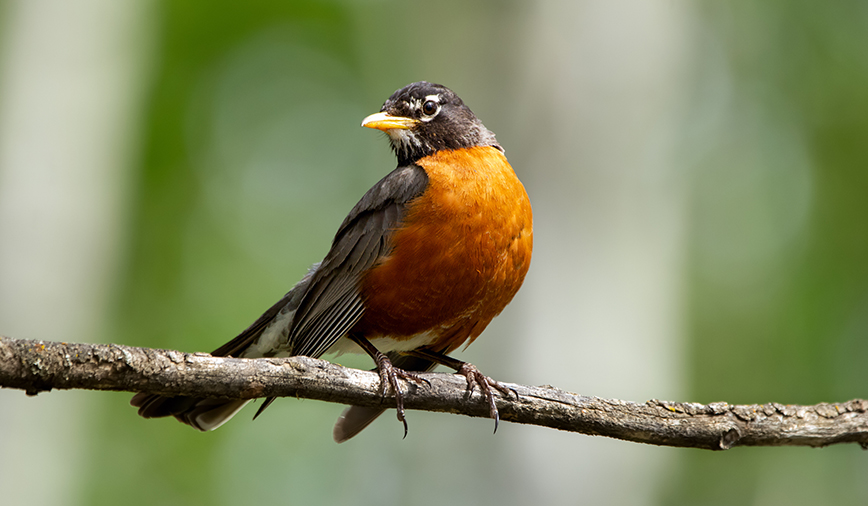Even if you’re one of those folks who believes the outdoors exists only to make the indoors more inviting, I’ll bet you noticed the robins. Their numbers started going up at the beginning of March and, by last week, little doubt existed that our quintessential sign of spring had returned. It’s true, the bluebirds and tree swallows are back too, along with the grackles, killdeers and turkey vultures, to name a few. But last week, when the sun glistened on the muddy melt of spring, virtually everyone noticed that the robins were back, and all was right with the world.
Then it snowed. Again. And people everywhere bemoaned Nature’s cruel trick. Who wouldn’t, after the sort of winter we’ve had? Nonetheless, a good number of individuals chose to rise above their own inconveniences and ask, “What about the robins?”
Indeed, what about the robins? Comfortingly attired in familiar gray, white and tomato-soup red, the American robin likely was the first bird you learned to identify. It may even be the only bird you learned to identify. And that’s just fine. What’s important to most people is the symbolism the robin unknowingly carries. As they hop around the lawn or sing from a tree, they reassure us that happy days are here again. Shoot, even their song is cheery–literally: “Cheeriup, cheerily, cheerup, cheerio!” the males sing as they proclaim a territory.
With this sort of significance attached to the robin, it’s no wonder people worry when the temperatures drop. Compounding the concern, I believe, may be a poem that’s been a staple of children’s nursery rhyme books for centuries. Remember this little ditty?
The North wind doth blow
And we shall have snow
And what will poor robin do then, poor thing?
He’ll sit in the barn, and keep himself warm
And hide his head under his wing, poor thing!
In case we missed the word the first two times, the author inserted “poor” a third time, just to make sure we understood the bird’s plight. But doth they really have it so bad?
In a word, no. Sure, these past few days haven’t been easy. But healthy birds are well equipped to handle such meteorological setbacks. They know where to roost to avoid the brunt of the wind; they have feathers they can fluff up to trap air and provide insulation; and they also can shiver—a vitally warming process that humans avoid, but many animals rely on to get through a cold spell.
Probably the main factor affecting our “poor” robins this past week was the quantity of available food. In fact, it’s the main reason they migrate in the first place. (The American robin’s scientific name is Turdus migratorius; more on this later.)
Despite what we’ve been brought up to believe, robins eat more than earthworms. In fact, when you look at what robins eat over the course of a year, worms aren’t even their primary food source. Fruits, especially berries, make up about 60% of the robin’s annual food intake, and can be crucial this time of year. The other 40% of the annual diet, consumed mainly during the breeding season, consists of high-protein fare like caterpillars, grubs and, yup, worms.
Remember when you were told that robins hunt worms by “listening?” Look closely this spring, when the snow is finally gone, and you’ll notice that the birds actually are scanning the ground with their eyes. Robins hunt by sight, not sound.
While we’re busting robin myths, we might as well throw one more on the heap: Robins don’t always migrate to sunny climes like Florida. Because they follow food supplies, robins’ migration routes are irregular. Sometimes, some robins even spend part of the winter right here. According to our good friends at Kane County Audubon, 42 American robins were spotted during the 2007 Christmas bird count on December 15.
With such variable movements, it can be tough to sort out who’s who. If you’d like to determine whether a springtime robin you’ve spotted is here to stay, or just passing through, watch and listen. Birds on a migration mission aren’t going to waste time and energy declaring a territory if they’re still miles from their summer homes. But a robin intent on staying will begin singing his cheery song soon after arrival.
Now, about that scientific name. Migratorius, you might have guessed, is Latin for migrating. Turdus is Latin for thrush, the family of birds to which robins belong. Did you guess that one, too? Good for you!
**
Another sign of spring is the prescribed burning of local natural areas. Join St. Charles Park District naturalists as we visit a recently burned area and discuss the reasons why burns are an important ecological process at After the Burn, to be held this Saturday from 1 to 3 p.m. at Campton Hills Park. Fee is $10. Refer to bar code 3978. For registration information, please call the Pottawatomie Community Center at 630-513-6200.
Pam Otto works for the St. Charles Park District and can be reached at potto@stcparks.org or 630-513-4346.

